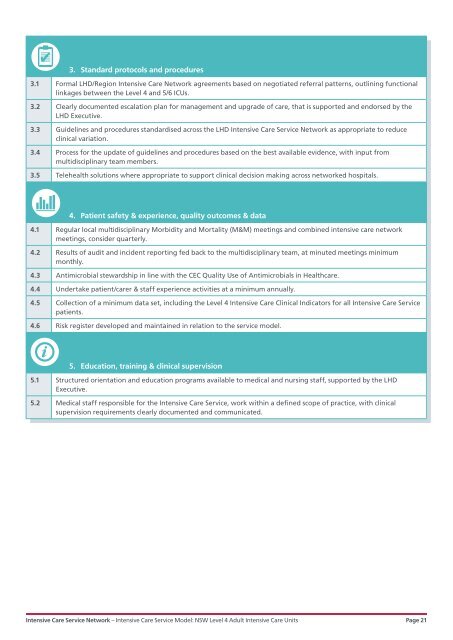Intensive Care Service Model NSW Level 4 Adult Intensive Care Units
1Olm7HQ
1Olm7HQ
Create successful ePaper yourself
Turn your PDF publications into a flip-book with our unique Google optimized e-Paper software.
3. Standard protocols and procedures<br />
3.1 Formal LHD/Region <strong>Intensive</strong> <strong>Care</strong> Network agreements based on negotiated referral patterns, outlining functional<br />
linkages between the <strong>Level</strong> 4 and 5/6 ICUs.<br />
3.2 Clearly documented escalation plan for management and upgrade of care, that is supported and endorsed by the<br />
LHD Executive.<br />
3.3 Guidelines and procedures standardised across the LHD <strong>Intensive</strong> <strong>Care</strong> <strong>Service</strong> Network as appropriate to reduce<br />
clinical variation.<br />
3.4 Process for the update of guidelines and procedures based on the best available evidence, with input from<br />
multidisciplinary team members.<br />
3.5 Telehealth solutions where appropriate to support clinical decision making across networked hospitals.<br />
4. Patient safety & experience, quality outcomes & data<br />
4.1 Regular local multidisciplinary Morbidity and Mortality (M&M) meetings and combined intensive care network<br />
meetings, consider quarterly.<br />
4.2 Results of audit and incident reporting fed back to the multidisciplinary team, at minuted meetings minimum<br />
monthly.<br />
4.3 Antimicrobial stewardship in line with the CEC Quality Use of Antimicrobials in Healthcare.<br />
4.4 Undertake patient/carer & staff experience activities at a minimum annually.<br />
4.5 Collection of a minimum data set, including the <strong>Level</strong> 4 <strong>Intensive</strong> <strong>Care</strong> Clinical Indicators for all <strong>Intensive</strong> <strong>Care</strong> <strong>Service</strong><br />
patients.<br />
4.6 Risk register developed and maintained in relation to the service model.<br />
5. Education, training & clinical supervision<br />
5.1 Structured orientation and education programs available to medical and nursing staff, supported by the LHD<br />
Executive.<br />
5.2 Medical staff responsible for the <strong>Intensive</strong> <strong>Care</strong> <strong>Service</strong>, work within a defined scope of practice, with clinical<br />
supervision requirements clearly documented and communicated.<br />
<strong>Intensive</strong> <strong>Care</strong> <strong>Service</strong> Network – <strong>Intensive</strong> <strong>Care</strong> <strong>Service</strong> <strong>Model</strong>: <strong>NSW</strong> <strong>Level</strong> 4 <strong>Adult</strong> <strong>Intensive</strong> <strong>Care</strong> <strong>Units</strong> Page 21


